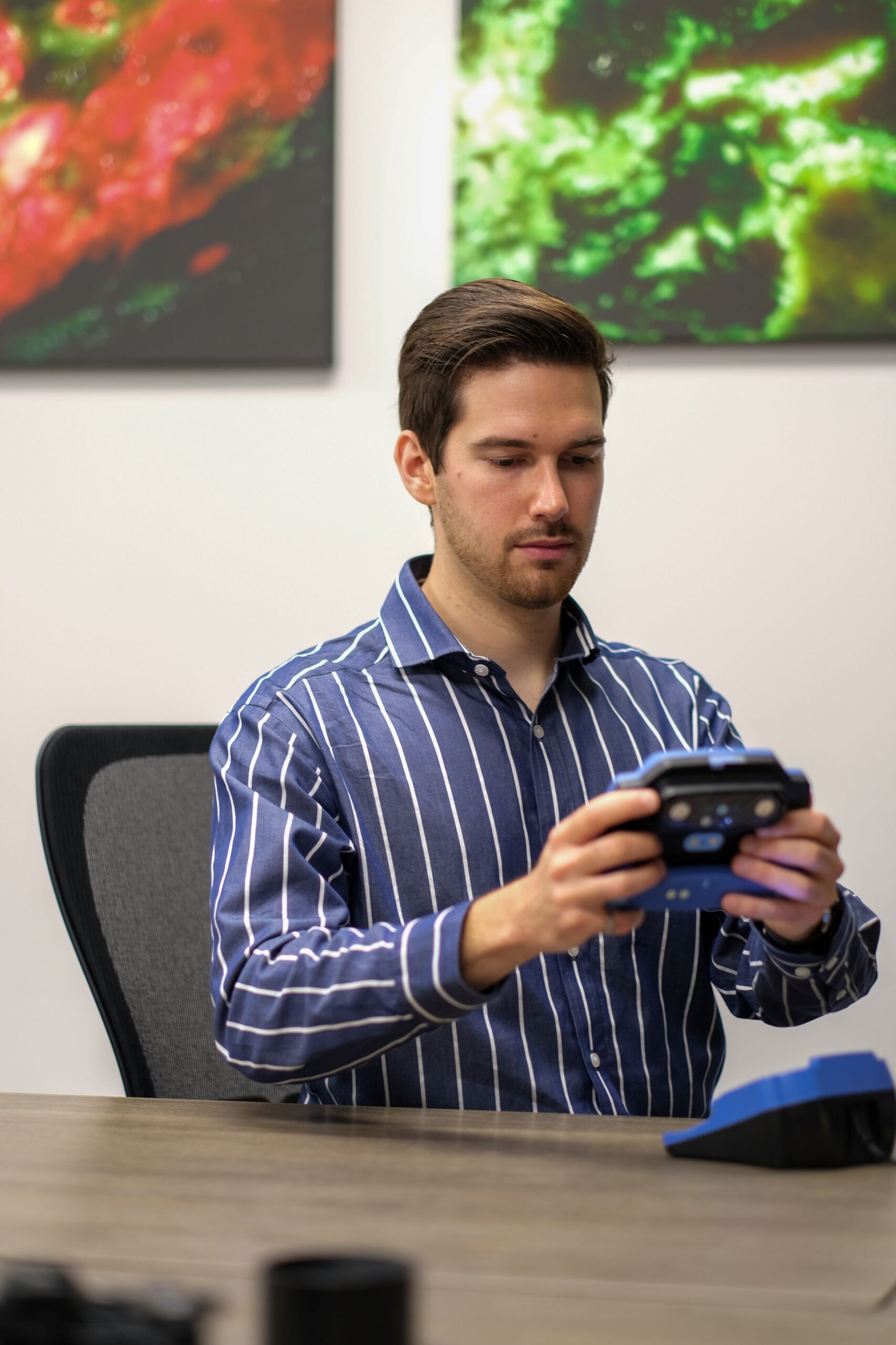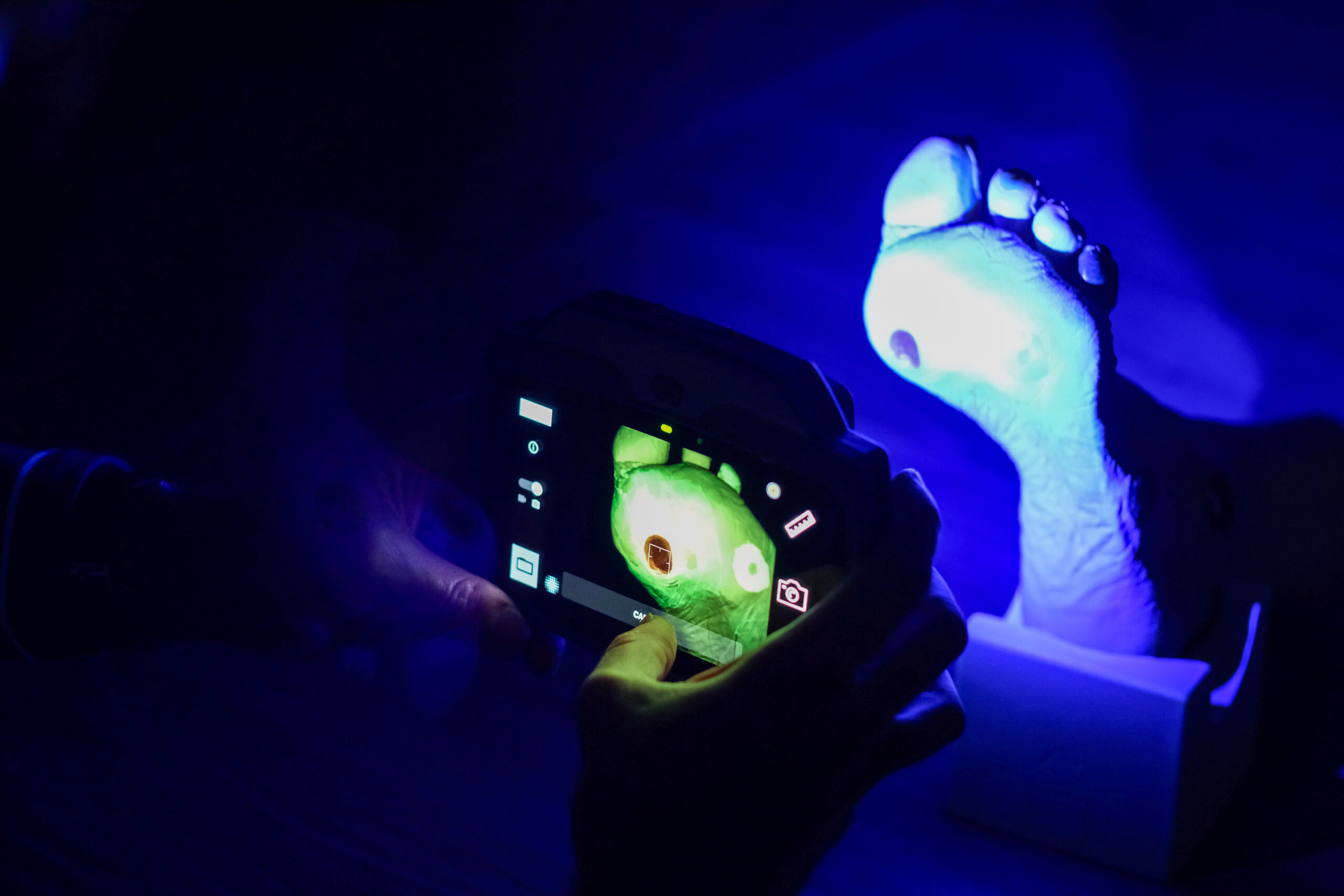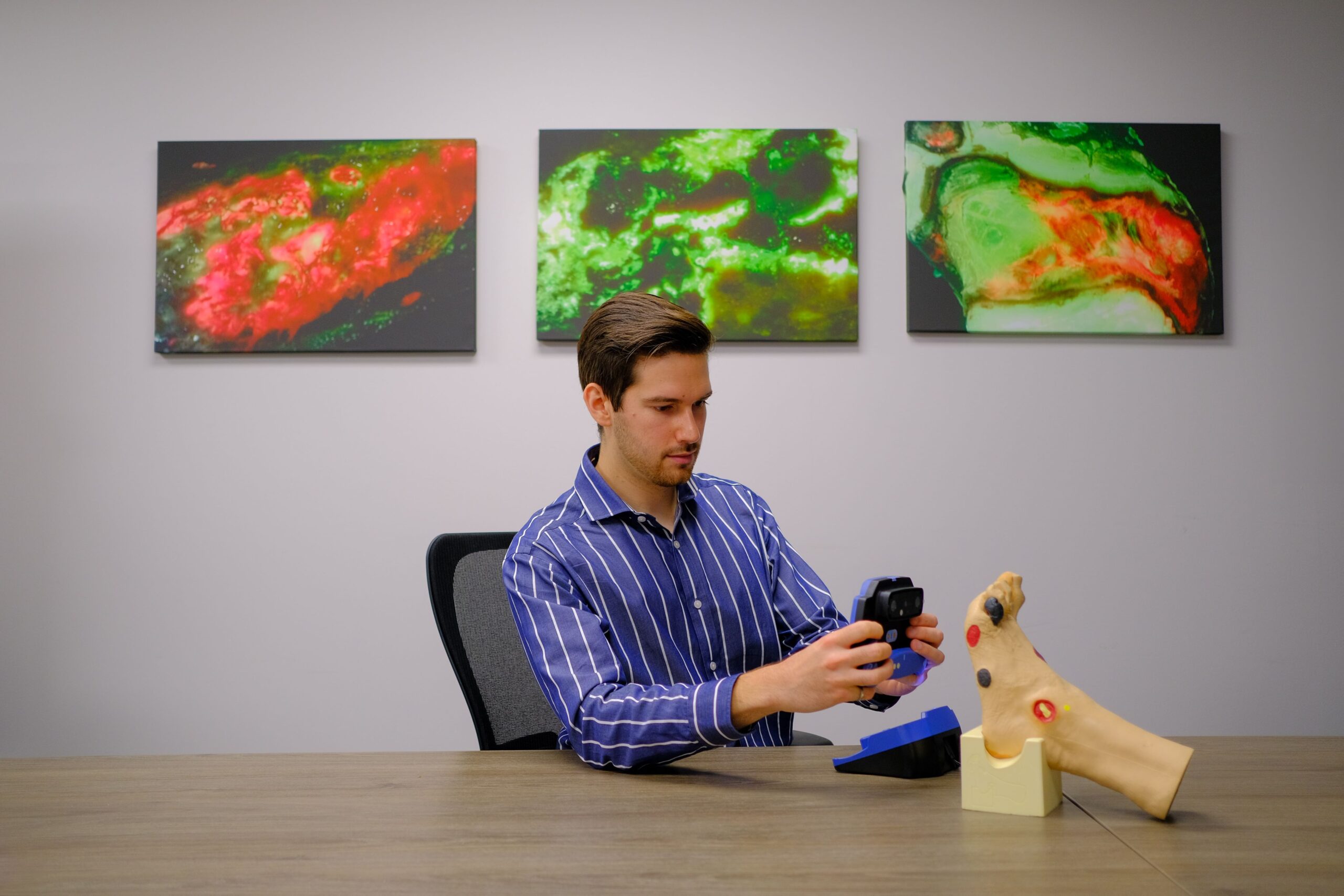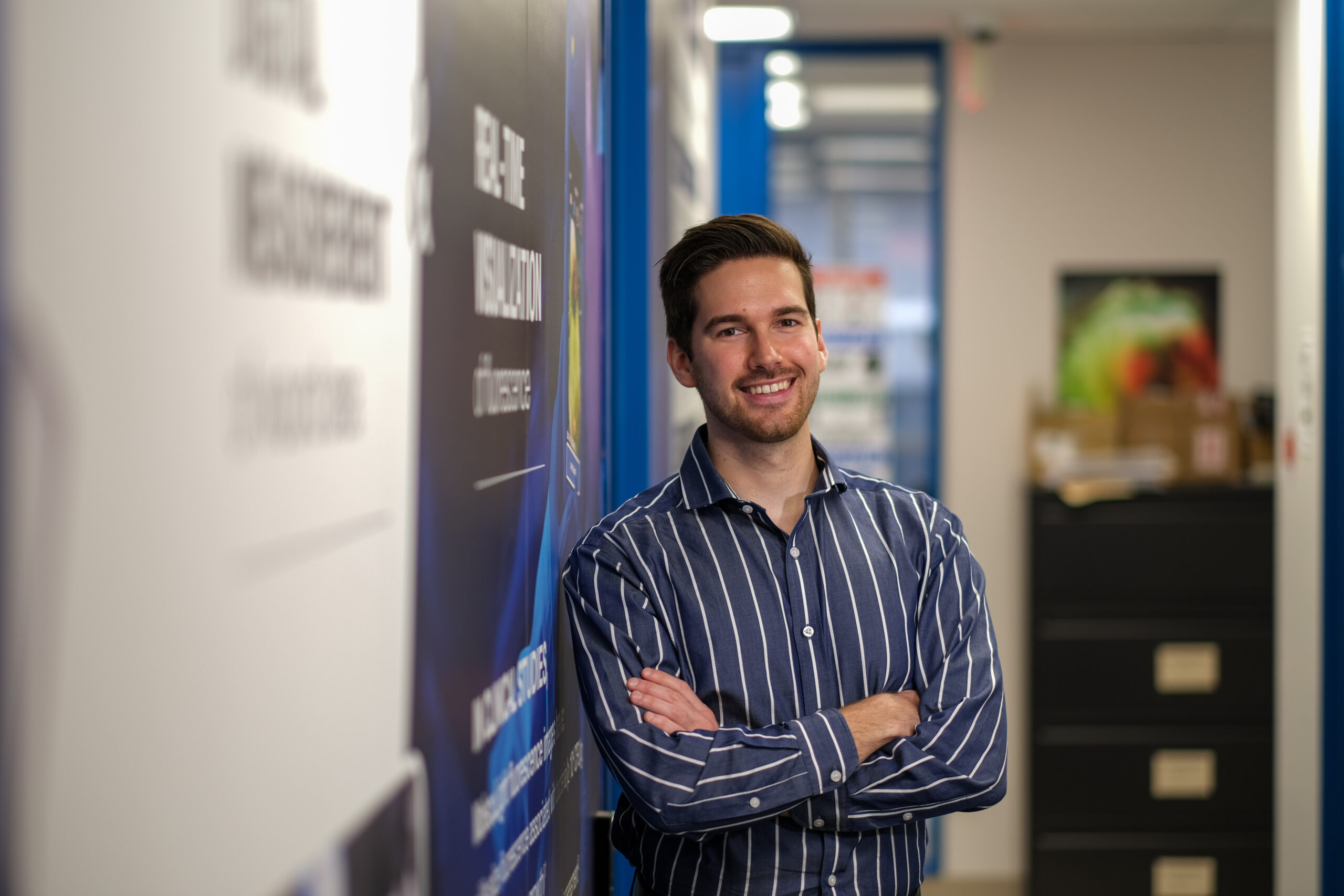In this Alumni Q&A, meet Nikola Andric, the Director of Product Development at MolecuLight, where he spearheads the advancement of fluorescence wound imaging devices for bacterial load visualization and wound measurement. Graduated from BME MEng program in 2017, Nikola is leveraging his diverse skill set honed during his U of T Engineering days. His pioneering work not only showcases a transformative passion for revolutionizing wound care but also reflects his dedication to innovation, seamless communication, and staying at the forefront of medical device trends.
Can you describe your current role and the day-to-day responsibilities that come with it?
I am the Director of Product Development at MolecuLight. MolecuLight manufactures fluorescence wound imaging medical devices that allow clinicians to visualize high bacterial loads in wounds and digitally measure wounds with a high degree of accuracy.
I wear many different hats in my role. Firstly, I am responsible for planning and executing our engineering projects to launch new products and features. This involves working closely with our engineering, quality, manufacturing, and clinical teams to ensure we build the right solutions with high quality. This also means creating efficient development processes for our multi-disciplinary team and ensuring these processes satisfy quality assurance. Additionally, I work closely with our customers and clinical team to define user needs and product specifications to then translate those into engineering requirements. My day-to-day responsibilities typically include morning scrum meetings with our engineering team to provide progress transparency and evaluate prototypes, working with the customers to define new product features, and implementing integrations with customers. A big part of my job in the last year has been implementing EMR integration solutions for our products with a variety of hospital institutions.

What’s your day to day like?
My day begins in the mornings where I have my scrum calls with the engineering team. We get together and make sure that we understand what everyone’s working on, our progress, and how we can eliminate any obstacles. I have regular calls with our clinical team to understand customer feedback and new developments from the field. With any free-time I can find, I work on product designs for upcoming products and features on our roadmap. This involves defining technical specifications for my team. Throughout the day, I follow up with the engineering and QA teams, making sure we’re on track with certain deliverables.
Can you talk about a specific project or achievement that you are particularly proud of in your current role?
In my current role, I’m particularly proud of the work I’ve done to integrate our medical device software and wound data with electronic medical record (EMR) systems. With medical devices, it’s important to understand that clinicians are busy and don’t have a lot of time to learn new workflows and perform new functions. Any solutions introduced into a clinical setting must be intuitive and as efficient as possible! This is something we are really focused on here at MolecuLight. I’ve recently led several projects to integrate our MolecuLightDX™ device into existing EMR systems. This allows clinicians to quickly capture their wound images and have the wound data automatically uploaded and documented in their medical records. I remember during my MEng program, we had a guest lecturer speak about the complexity of hospital IT systems and how we can strive to better integrate data into these systems. That lecture always stuck with me and now I’m fortunate to have had hands-on experience working with these EMR systems to streamline clinician workflows.
How does your flagship product, MolecuLightDX, work in a clinical setting?
Currently, clinicians in wound care rely on capturing white light images of wounds and taking manual measurements using tools like smartphones, iPads, or cameras. Our goal with the MolecuLightDX is to introduce a more advanced and powerful imaging modality specific to wound care. Similar to X-rays or MRIs, our device offers a unique imaging approach to address an important challenge – detecting bacterial loads within wounds at the point-of-care and to do so in real-time, something that conventional methods are unable to do.
The MolecuLightDX is designed to be a portable, user-friendly point-of-care device that fits easily into a clinician’s pocket. It empowers clinicians to capture crucial wound data quickly and efficiently during their visits to inform their clinical decision-making. For instance, during my recent work trip, I accompanied clinicians to various remote locations, including nursing homes and patients’ homes. The device allows them to not only perform wound care procedures but also gather essential data about wound size, healing progress, and bacterial burden on the spot. This eliminates the need for time-consuming bacterial swabs and lab testing while simultaneously assisting clinicians with targeted cleaning and debridement.
Our device is carefully crafted for mobility and ease of use. Its design facilitates one-handed operation and can be used by both left- and right-handed users. It addresses the practical needs of clinicians who work in diverse environments, from healthcare facilities to patients’ homes. In essence, the MolecuLightDX enhances the entire wound care process by providing real-time, accurate, and accessible imaging and measurement capabilities, contributing to more effective patient care.
Our global user base, including thousands of physicians and nurse practitioners, handles complex wound cases with multiple procedures. We’re focused on streamlining their tasks without burdening them further. Unlike some competitors, our approach is entirely non-contact, accurately measuring wounds without attaching markers. Additionally, we address connectivity challenges. Our technology integrates with medical record systems, ensuring functionality even without strong Wi-Fi, which is crucial for effective care delivery, especially in patients’ homes.
Security is another critical dimension. Our device prioritizes robust security for patient data storage, distinguishing us from phones susceptible to vulnerabilities. We strike a balance between security, user-friendliness, and durability. Our devices are engineered for real-world clinical demands, showcasing our commitment to trusted and reliable medical technology.


What skills and knowledge have been most valuable to you in your current job, and how did you acquire them?
In terms of valuable skills: critical thinking, problem solving, and communication. I attribute my problem solving and critical thinking skills to my time at U of T engineering. Understanding how to approach a complex problem is critical in my role. As a student, I had lots of practice working on technical group projects. Communication is extremely important when working in a multi-disciplinary team. Customers speak a different language than engineers and it’s important to effectively communicate product concepts to different audiences. I got a lot of practice doing this when I was in student government and theatre groups at U of T.
The MEng program gave me a general understanding of how medical devices are developed and the processes involved from the QA and regulatory perspective to ensure high quality products with low risk to patient and users. I apply this knowledge daily since I am in charge of managing our development projects. Understanding the regulatory pathways for the FDA was also critical from a business perspective. Any new plan to launch a medical device starts with understanding how the product will be approved by regulatory bodies.
In my undergrad, I gained a background in microbiology through my research summers and thesis in bioengineering. My professional experience year (PEY) was also focused on imaging technologies. Combining my experience with bacteria and imaging – MolecuLight seemed liked the perfect fit!
What do you enjoy most about your current job, and what are some of the biggest challenges you face?
I am extremely passionate about our product and the clinical impact MolecuLight is making in wound care. We are the only FDA cleared medical device that allows fluorescence wound imaging to visualize high bacterial loads – and our device is well on the way to become a global standard in wound care. I’ve seen first-hand and through numerous case studies how our wound imaging procedure can greatly impact patient outcomes. This could mean less antibiotic usage, fewer amputations, and faster wound healing times. We are building a whole new imaging modality to completely revolutionize wound care, and I think that’s very exciting!
The biggest challenge I face in my role is making sure we build the right product and right workflow! There are endless problems to solve in wound care and countless different solutions. However, to build a truly successful and impactful product, it’s important to listen to users and truly uncover their needs and critical issues they are facing. You can’t solve everything at once so you must be strategic with how you implement solutions.

What are some important trends or changes happening in your industry, and how do you see them affecting your job or the field in the future?
The predictive power of AI. AI is on track to change lots of industries, healthcare included. There are many medical data software companies who are looking to capitalize on AI to better predict patient outcomes and suggest clinical interventions. The idea here is to be proactive rather than reactive. Like other imaging modalities (X-Rays, MRI’s, Ultrasounds), our fluorescence wound imaging relies on image interpretation. Clinicians are trained to interpret medical images to determine a treatment plan. One can imagine that AI algorithms could be developed and taught to interpret medical images for clinicians. This could lead to both cost and time savings.
How do you stay up-to-date with the latest developments and trends in your field, and what resources do you recommend for others interested in doing the same?
This is a hard question to answer because I wish I did a better job at this. One thing I do is follow a wide range of medical device companies on LinkedIn. All companies do press releases and post new updates on their LinkedIn profiles. It’s a great way to stay up to date. Also, MolecuLight has a medical communications team that regularly releases publications and works with key opinion leaders to document interesting new findings in wound care. I make sure to stay-up to date with our publications and any other wound care publications. I also am not afraid to ask questions. Whether it’s within a different department in your company or when you’re at a customer site, if you are curious and don’t know a lot about something, always speak up!


